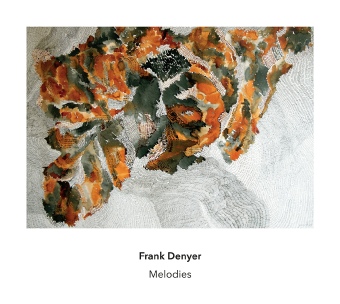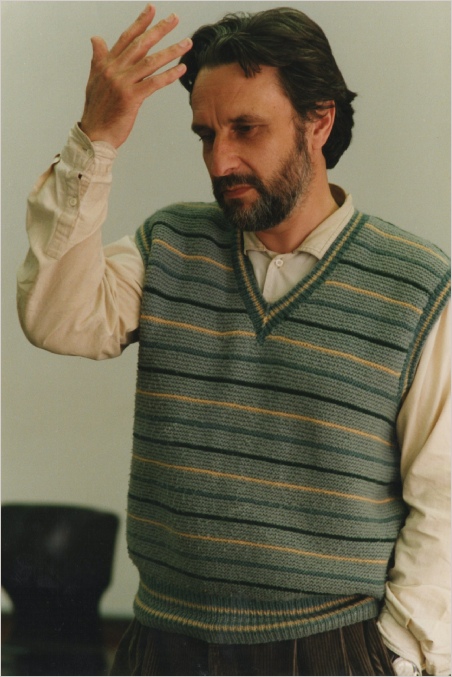Another Timbre TimHarrisonbre

at203x2 Frank Denyer ‘Melodies’ (1974-77)
First recording of a fascinating project from the mid-1970’s, arising from Frank Denyer ethno-musicological studies from that time in India, Kenya and Japan, which forced him to question the fundamentals of music, asking ‘what is a melody?’ and ‘what is a note?’
Denyer decidied to answer these questions by composing a series of 25 short pieces, starting with melodies for a single note, then melodies for 2, 3, 4, 5 and 6 notes, ending with more complex melodies for fourteen and fifteen notes.
Performed by Scordatura Ensemble, the Luna String Quartet, Mad Song and Frank Denyer himself, on two CDs, accompanied by a 24-page booklet specially written by Denyer.
If you want a pdf copy of the booklet, please email us at info(at)anothertimbre.com
Introduction to the 24-page booklet by Frank Denyer that accompanies the double CD
It is now more than half a century since I first became interested in forms of traditional music made from just two, three or four notes. These restrictive forms were the particular concern of comparative musicologists in the first half of the twentieth century, who were fascinated not only by societies whose musical life had seemingly evolved entirely within these bounds, but also with the significance that such forms existed, and still exist, on every continent and in every age. This wide geographical distribution would indicate very early, probably archaic, origins. Such forms might therefore be considered an archetypal part of our common musical heritage, under-pinning all musical cultures. Such a hypothesis is reinforced by their appearance as part of every infant’s earliest vocalisations and also in their presence in the oldest chanting traditions of the world’s great religions.
When thinking about these seemingly simple structures, I soon found myself reconsidering some fundamental musical concepts that seemed surprisingly relevant to contemporary composition. First and foremost was the question - “what exactly is a note?” Is it the same as a particular pitch or frequency? Up to that point I had assumed that these were almost synonymous and certainly none of my composition teachers had ever suggested otherwise, but now I was gradually realising that a note was not at all the same as a discrete frequency, for even within the formal world of western classical music slight changes in intonation in response to particular harmonic (or melodic) contexts are normal practice. These might be extremely small, but nevertheless a note becomes a narrow flexible band of frequencies rather than a single fixed point. Beyond the world of western classical music, particularly in music with fewer notes in its gamut, such pitch tolerance can have more latitude. Intonation in western classical music can only be modified to a very limited degree because an octave packed with twelve semitones leaves little room for manoeuvre. A note that is too variable in pitch soon becomes confused with its near neighbour and to prevent this, a distinct no-man’s land is placed between each, which, if ventured upon, is experienced as being ‘out of tune’. But there is little danger of this in a two-note system where one note might take its identity merely from being higher or lower than its companion.
Long before I could personally experience any of the more sophisticated examples from around the world, I was scouring libraries of recorded sound at home, slowly accumulating what became a sizeable collection. Having roots deep in our prehistory does not mean that every example originated long ago, for such structures are still being created today, and not only by hunter-gatherer or other roaming groups. They are to be found in contemporary contexts in the industrialised world such as the vocal parts of some commercial pop music for instance. Being fundamental to our musical experience and history, they are surely worthy of more than a passing glance from aspiring composers.
At some point in 1973 I decided that I would better understand the implications and potential of these observations if I composed a small two-note melody myself. At first I had no thought of it being more than a sort of learning exercise. However, I soon found that this small task was more difficult than anticipated, and the questions it posed too great for me to deal with. I was certainly nowhere near ready to take on the further problems when pitch interacted with metre, rhythm, dynamics or timbre. Obviously I would have to start with something simpler – a one-note melody.
But another fundamental question immediately arose. “When is a change of pitch perceived as a new note, and under what circumstances might it appear as just a variant of the same one?” This is more complex than it seems. At the simplest level, a note with a trill is easily perceived as having the same basic identity as a notewithout a trill. It is the same with other ornaments: even if a portamento or glissando is attached to the beginning or end, it will probably still be heard as the same note even if the frequency change has been considerable. These are simple musical examples, but real musical discourse is altogether a different thing, where interesting ambiguities can arise and a change of pitch can be perceived as either a new note or the same, or both. Musical perception depends a lot on context.
It began to dawn on me that a note could be individually characterised by the width and nature of its pitch band, and through that microstructure become endowed with a special identity. Looking forward, it seemed that if I slowly proceeded down this path I might eventually be able to extend these ideas to systems of five, six or even more notes and, who knows, this might then evolve into a novel self-sustaining melodic language. But wait! At this stage I was having trouble with one- and two-note structures, so this was merely an idle fantasy, and, of course, I had no idea what such a music might sound like.
And so this simple exercise began its slow transformation into an idea for an extended composition, one that would enable the listener to experience this birth of melody, albeit within the course of a single work. As time went by I gradually came to feel more at home with these concepts, but it still took three years (1974 to 1977) for Melodies to fully emerge.
If you want a pdf copy of the booklet, please email us at info(at)anothertimbre.com

Frank Denyer


CD 1
Part One
1 1-note melody Karnatic bansuri (bamboo flute) 1' 29
2 1-note melody French horn, stones 2' 23
3 1-note melody prepared c concert flute 1' 08
4 2-note melody sneh, bamboo switch, bass drum 1' 20
5 2-note melody male voice 1' 55
6 2-note melody double bass, bass drum, guiro, high drum 2' 58
7 3-note melody sneh, santur, baroque traverso 2' 01
8 3-note melody male voice 1' 48
9 1st Interlude two percussionists with two female vocalists 2' 34
Part Two
10 4-note melody female voice 2' 36
11 4-note melody viola (scordatura tuning) 2' 32
12 5-note melody male voice, metal slabs 3' 51
13 5-note melody two double basses, tuba 4' 03
14 6-note melody female voice), sneh, flute, percussion, horn 4' 17
15 2nd Interlude three boxes and bell 5' 55
Part Three
16 7-note melody string quartet (heavy mutes), box, crotales 4' 14
17 8-note melody double bass, muffled tenor drum 4' 20
18 9-note melody muted viola/female voice 3' 41
CD 2
1 3rd Interlude three male vocalists with percussion instruments 4' 26
Part Four
2 10-note melody violin (heavy mute), female voice 4' 41
3 11-note melody female voice, muted viola, flute, cimbalom, percussion 5’ 52
4 12-note melody cello (heavy mute), percussion 6' 26
5 4th Interlude bass flute, two double basses, prepared tuba, percussion 5’ 12
Part Five
6 13-note melody triple muted viola/female voice, two percussionists 7:31
7 14-note melody and 15-note epilogue string quartet, two percussionists 9’ 47